|
| |
|
|
 |
|
It is difficult to capture on film the soil foraging excavations of giant sengis. This immature Rhynchocyon chrysopygus is digging in the soil below the leaf litter. |
| |
|
|
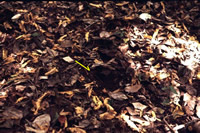 |
|
Foraging in moist soil, usually for earthworms, results in small triangular (arrow to apex) holes ca. 4 cm deep with sharp edges. Fresh soil is usually scattered on the surface of leaves on one side, adjacent to the hole. Foraging excavations are only evident for a day or two before surrounding leaf litter obscures them.
|
| |
|
|
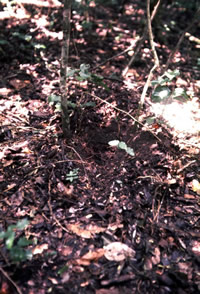 |
|
A partially constructed nest on the forest floor, showing the oval bowl excavated in the soil with exposed rootlets. |
| |
|
|
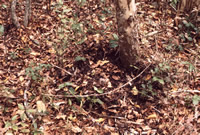 |
|
Freshly constructed nests are relatively easy to spot because of the exposed soil surrounding the dome of leaves. |
| |
|
|
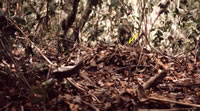 |
|
Weathered nests (arrow) are only distinguished from the surrounding leaf litter by a slight mound of leaves. With time, even the dome blends into the surrounding leaf litter and the nest essentially becomes undetectable. |
| |
|
|
 |
|
Obstructing vegetation (poles) and dappled lighting on the forest floor make it difficult to a spot nest (arrow) on the forest floor. |
| |
|
|
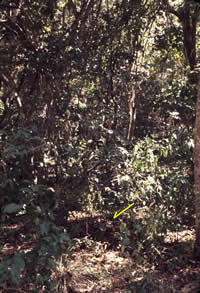 |
|
Old unused nests can be identified by the collapse of the leaf dome in the centre (arrow), the result of decomposing leaves dropping into the soil nest cavity. |
| |
|
|
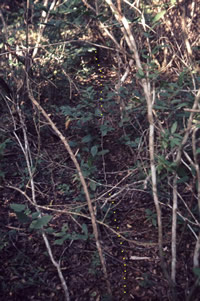 |
|
Rhynchocyon does not normally use trails, but under certain conditions, such as through particularly dense vegetation, very indistinct paths sometimes develop from repeated use. The yellow dots and white string on the forest floor are down the middle of an indistinct path habitually used by Rhynchocyon chrysopygus. Petrodromus actually builds and maintains very distinct paths through forest leaf litter, which are often appear as a regular series of bare patches where these sengis land when bounding (they do not hop bi-pedally, like kangaroos). Similar paths are constructed by several species of Elephantulus, which are not forest dwellers. |
| |
|
|
|
| |
|
|
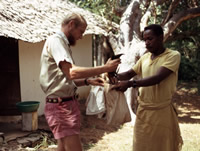 |
|
Sengis that are captured are best kept in cloth bags or pillow cases. Local residents that hunt and trap in the area can be hired as bounty hunters to provide specimens. |
| |
|
|
 |
|
Fishing nets can be strung along existing paths through the forest. Where there are no limbs or saplings nearby, the nets can be suspended from long, thin twigs stuck into the soil. |
| |
|
|
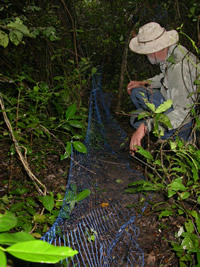 |
|
If paths do not exist through the forest, low-impact paths can be quickly cut through
the vegetation and nets hung from twigs and branches (Boza, Pangani, Tanzania). |
| |
|
|
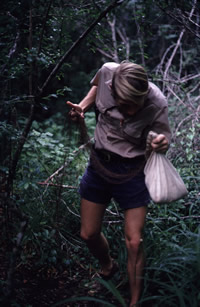 |
|
Nets are easily stored in, and unfurled from, cloth bags similar to those used for sengis.
|
| |
|
|
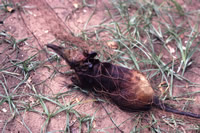 |
|
Giant sengis entangled in netting are susceptible to predation and injury.
Nets should be checked every 1-2 hours and collapsed at night or when not being monitored. |
| |
|
|
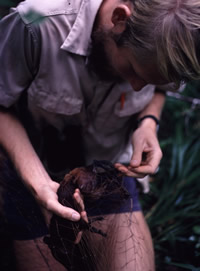 |
|
Sengis should be removed carefully from nets because their rear legs are easily broken and their eyes can be damaged. If needed, cut the net and repair it later. |
| |
|
|
 |
|
Giant sengis do not bite, but they can inflict wounds by kicking with their strong rear legs. Sengis in-hand will seem docile, and then when you are least expecting it they will burst into a fit of flailing legs in an attempt to escape. While photographing captives, ensure that you have full control of their rear legs and head, as shown. |
